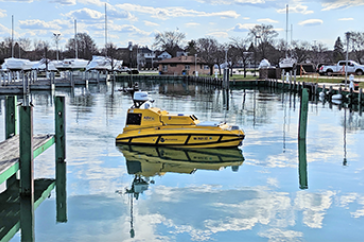UNH Seafloor Mapping Robot Instrumental in Discovering Shipwreck in Lake Huron

UNH’s autonomous surface vehicle, BEN, prepares to head out from Rogers City Marina for a day of underwater mapping to help in the search for the Ironton which sank in Lake Huron in 1894.Credit: UNH
DURHAM, N.H.—Researchers from the University of New Hampshire were part of a world-renowned team that found an intact shipwreck hundreds of feet below the surface of Lake Huron. Looking like it was frozen in time, the 191-foot, three masted sailing ship Ironton sank in the waters of Lake Huron in 1894. UNH’s autonomous surface vehicle (ASV) named BEN (Bathymetric Explorer and Navigator) provided state-of-the-art underwater mapping technology which was instrumental in the discovery.
During this NOAA-led expedition, UNH worked with several search teams made up of scientists, historians and underwater archaeologists including those from the state of Michigan and the Ocean Exploration Trust, founded by famed explorer Robert Ballard, who located the wreckage of the Titanic.
“This was an exciting expedition for our researchers and students to be a part of and is exactly the kind of ocean mapping BEN was built to do,” said Val Schmidt, principal research project manager and UNH team lead. “The autonomous surface vehicle is designed to explore the seafloor or lakebeds, especially in areas that may be too deep for divers or too shallow for larger ships.”
BEN is operated by UNH’s Center for Coastal and Ocean Mapping (CCOM) and contains state-of-the-art seafloor mapping systems. The 12-foot, diesel-powered, self-driving boat is equipped with a high-resolution multibeam sonar that allows it to make 3D topographic and acoustic backscatter maps of an ocean floor, or for this mission, a lakebed. BEN worked in tandem with NOAA's Great Lakes Environmental Research Lab's RV Storm, which has similar equipment, to map the area where Ironton was thought to be located. After days of mapping, persistence and determination the team produced an image of a shipwreck that matched the description of Ironton.
“The sonar images were spectacular,” said Schmidt. “The vessel was preserved in the Great Lake resting right side up, masts still standing as though it just sailed down to the bottom of the lake.”
BEN’s seafloor mapping systems include a Kongsberg EM2040P multibeam echo-sounder and Applanix POS/MV navigation system. CCOM developed mission planning and “back-seat-driver" control software designed specifically for piloting BEN. BEN was manufactured by ASV Global, in a design collaboration with CCOM.
More information about the expedition is available on NOAA’s Thunder Bay National Marine Sanctuary website: https://sanctuaries.noaa.gov/news/mar23/ironton-discovery.html
The University of New Hampshire inspires innovation and transforms lives in our state, nation and world. More than 16,000 students from all 50 states and 71 countries engage with an award-winning faculty in top-ranked programs in business, engineering, law, health and human services, liberal arts and the sciences across more than 200 programs of study. A Carnegie Classification R1 institution, UNH partners with NASA, NOAA, NSF and NIH, and received $260 million in competitive external funding in FY21 to further explore and define the frontiers of land, sea and space.
PHOTOS FOR DOWNLOAD
Photo: https://ccom.unh.edu/sites/default/files/images/ben/BEN-marina.jpg
Caption:UNH’s autonomous surface vehicle, BEN, prepares to head out from Rogers City Marina for a day of underwater mapping to help in the search for the Ironton which sank in Lake Huron in 1894.
Credit: UNH
Photo: https://ccom.unh.edu/sites/default/files/images/ben/sonar.png
Caption: Image of the schooner-barge Ironton as it sits on the lake floor today. This multi-colored image of the sailboat with its three masts is from a point cloud extracted from water column returns from multibeam sonar.
Credit: Ocean Exploration Trust/NOAA Thunder Bay National Marine Sanctuary
Photo: https://ccom.unh.edu/sites/default/files/images/ben/BEN-trailer-Lake-Huron.jpg
Caption: UNH’s ASV-BEN docked after a long day of surveying on Lake Huron to try and locate the sailing ship Ironton which sank in 1894. It is next to the UNH ASV Control Van, which remotely operates BEN.
Credit: UNH
Photo: https://ccom.unh.edu/sites/default/files/images/ben/BEN-team-in-trailer.jpg
Caption: Inside UNH ASV control van, team lead Val Schmidt maintains watch over BEN during survey operations to locate the Ironton shipwreck, which sank in 1894. Coral Moreno, UNH PhD Student, works on algorithm development.
Credit: UNH
Latest News
-
May 7, 2024
-
April 26, 2024
-
April 16, 2024
-
April 16, 2024
-
April 16, 2024
















































